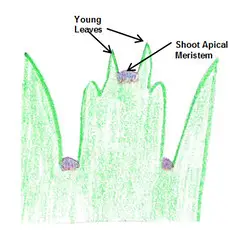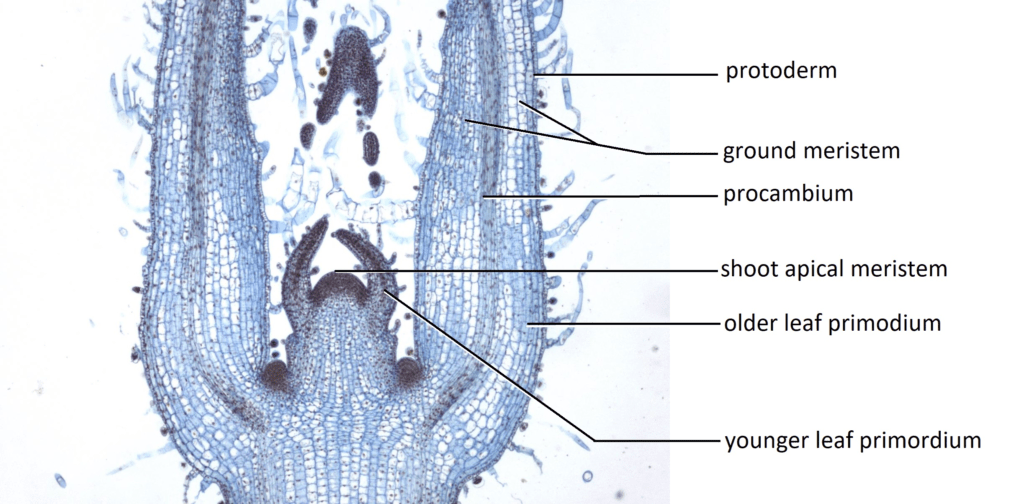The shoot apical meristem can be located at the plant’s tips, as observed in numerous dicots, or it may initiate slightly below the soil surface, giving rise to upward-growing leaves, as commonly seen in monocots.
Apical Meristems:
The apices of the stem and root are called growing points. Meristematic tissues occupy them. These meristems are called apical meristems.
The sole activity of apical meristems derives from all the primary permanent tissues of the plant body. The apical meristem consists of the upper pro meristem and lower primary meristem.

The cells are differentiated into three fundamental units in the primary meristematic region. These are protoderm (gives epidermal tissue system), ground meristem (gives ground tissue system), and procambium (gives vascular tissue system).
Different organs of the plant body are initiated by pro meristem and built up by primary meristem.
Shoot Apex
In higher plants, the meristematic cells at the tip of the central shoot axis, or a branch there, constitute a primary shoot meristem, or shoot-apical meristem. The terminal part of the shoot that lies above the level of young leaf primordium is called the shoot apex.
The shoot apex is radially symmetrical. As the shoot apex has leaf primordia, nodes, and internodes, it is more complicated than the root apex.
The shape and size of the shoot apex vary among vascular plants. In most angiosperms, the shoot apex is cone-like with a rounded apex. But in some members (Hibiscus sp.), it is concave.
At the initiation of leaf primordium, the shoot apex shows rhythmic changes. It widens (maximal phase) before the initiation of the leaf and gets narrow (minimal- phase) afterward. The width of the shoot apex varies from 90 (grass) to 3.5 mm (Cycas revolute).

A) Types of shoot Apices:
Newman (1961) has recognized three types of shoot apices in vascular plants on the basis of the number of cells or the number of rows of apical cells.
Monoplex Type:
This type of shoot apex is reported in ferns and allied members. The shoot apex generally consists of one or a few initial cells. The cells face inwardly. The cells divide parallel to the surface of the stem apex and give rise to tissues.
Simplex Type:
This type of shoot apex is found in gymnosperms. The shoot apex consists of one layer of initial cells. The cells divide anticlinally and periclinally and give rise to different tissues of the primary plant body.
Duplex Type:
In this type of shoot apex, the initials are arranged in two rows. It is found mostly in angiosperms. The outer layer cells divide anticlinally, whereas the inner layer cells divide anticlinally as well as in a periclinal manner.
B) Regions of Shoot Apex:
Wardlaw (1968) distinguished five integrated and interrelated zones in the shoot apex.
Distal Region:
The extreme tip portion of the shoot apex is called a distal region. It is composed of one or two tiers of apical initials.
Organogenic Region:
The meristematic region responsible for initiating the first organ, i.e., leaf primordium, is known as the organogenic region. Early meristematic tissue differentiation begins in this zone.
Sub-Apical Region:
In this region, continuous cell division and cell elongation take place. The cells differentiate into different tissues of the primary plant body.
Region of Maturation:
In this zone, the cells lose their meristematic nature. As the name indicates, cell maturation begins in this zone.
Theories of Shoot Apical Organization
Several scientists have extensively studied the shoot apical organization in vascular plants and postulated different theories from time to time. Three outstanding theories have been discussed in this text.
A. Apical Cell Theory
Apical cell theory was proposed by Hofmeister (1852) and supported by Nageli (1859). Scientists have observed single apical cells in Algae, Bryophytes, and Pteridophyta members. The single cell is the structural and functional unit of the apical meristem.
The inverted tetrahedral apical cell divides, giving rise to the entire plant body in cryptogams. Scientists have believed that similar shoot apical organization was present in phanerogams too.
But further investigations clarified that apical cell theory is applicable to the shoot apical organization of cryptogams but not phanerogams. Because in phanerogams group of apical cells is present.
B. Histogen Theory:
Histogen theory was proposed by Hanstein (1868) and supported by Strassburger. He recognized three distinct zones, dermatogen, periblem, and pleurome in shoot and root apical meristems. He called them halogens or tissue builders.
They perform different functions. Each zone is composed of a group of initial cells. Further, he believed these zones are derived from separate sets of initials.
Dermatogen:
The outermost tissue builder is called dermatogen. The cells of dermatogen divide anticlinally and give rise to the epidermal layer of plant organs.
Periblem:
It is the multilayered zone that lies beneath the dermatogen. The periblem cells divide into anticlinal and periclinal planes, giving rise to the cortex and endodermis.
Pleurome:
Pleurome is the multilayered central core. It gives rise to the pericycle, vascular tissues, pith, and medullary rays.
Recent experiments revealed no clear demarcation between different histogens and a rigid relationship between histogens and tissue formations in short regions. Hence this theory does not explain shoot apex organization very clearly.
However, even today, this theory applies to the root apex. Haberlandt proposed protoderm, ground meristem, and procambium for dermatogen, periblem, and pleurome respectively.
C. Tunica Corpus Theory:
This theory was propounded by Schmidt (1924) to explain shoot apex organization phanerogams. According to this theory, two distinct zones, tunica and corpus can be recognized in the apical meristems.
The tunica and corpus originate from a separate set of initials. The two zones are clearly distinguished from each other based on cell size and plane of cell division.
The Tunica:
In apical meristem, the outer enveloping zone is called a tunica. It may be a single-layered or two to three-layered structure. In this zone, the cells are very small and are arranged in definite rows. In this zone, the cells divide in the anticlinal plane only.
If the tunica is single-layered, it produces an outer covering, the epidermis of the plant body. If it is two to three-layered, the outer produce the epidermis, and the inner layers produce the outer cortical layers. In the tunica, the number of layers of initials is equal to the number of layers of tunica.
The Corpus:
The multi-cellular central core covered with the tunica mantle is called a corpus. This zone is composed of larger cells. The cells are not arranged in definite rows as in tunica. The corpus cells divide into all planes.
All the tissues of the organ other than the tissues formed from tunica are produced by the corpus (viz., Cortex; endodermis; pericycle; vascular bundles & pith). Tunica and corpus theory are applicable to shoot apex organization in spermatophytes. The corpus arises from a single tier of initials.
Key points
- 🌱 The apices of the stem and root are called growing points and are occupied by meristematic tissues.
- 🌱 The primary permanent tissues of the plant body are derived from the activity of apical meristems.
- 🌱 The apical meristem consists of the upper pro meristem and lower primary meristem, which differentiate into protoderm, ground meristem, and procambium.
- 🌱 Shoot apex refers to the meristematic cells at the tip of the central shoot axis, which is more complex than the root apex.
- 🌱 The shoot apex varies in shape and size among vascular plants, with most angiosperms having a cone-like shape.
- 🌱 Shoot apex shows rhythmic changes during leaf initiation, widening before leaf initiation and narrowing afterward.
- 🌱 There are three types of shoot apices: monoplex type (ferns), simplex type (gymnosperms), and duplex type (angiosperms).
- 🌱 The shoot apex consists of different regions: distal region, organogenic region, sub-apical region, and region of maturation.
- 🌱 Theories of shoot apical organization include the apical cell theory, histogen theory, and tunica corpus theory.
- 🌱 The tunica corpus theory explains the organization of shoot apex in angiosperms, with the tunica as the outer enveloping zone and the corpus as the central core.
FAQs
What is shoot apical meristem made of?
The shoot apical meristem comprises four distinct cell types: stem cells, daughter stem cells, founder cells responsible for initiating organ development, and an organizing center. Within the apical meristem
Where is Shoot Meristem?
The shoot apical meristem can be located at the plant’s tips, as observed in numerous dicots, or it may initiate slightly below the soil surface, giving rise to upward-growing leaves, as commonly seen in monocots. Regardless of the plant group, the shoot apical meristem is the central hub for all above-ground growth, dictating the plant’s overall development.
What is the function of shoot apical?
Throughout the lifespan of higher plants, the shoot apical meristem (SAM) plays a vital role in producing above-ground aerial organs. To effectively carry out this function, the meristem must carefully maintain a delicate equilibrium between the self-renewal of central stem cells and the initiation of organs from peripheral cells.
What are 3 examples of apical meristem?
The shoot apical meristem produces three primary meristems: procambium, ground meristem, and protoderm. Among these, the procambium specifically generates vascular tissues, contributing to the plant’s vascular system.
